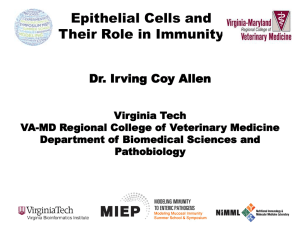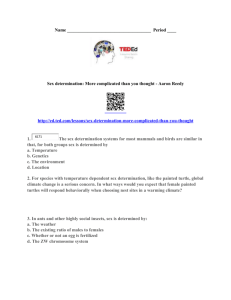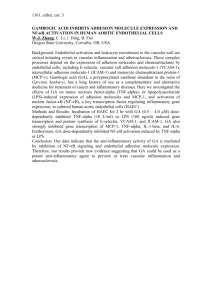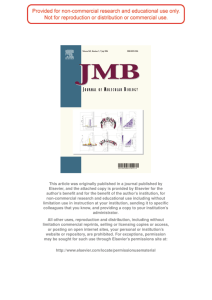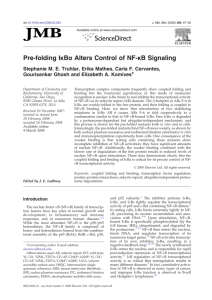manuscript file
advertisement
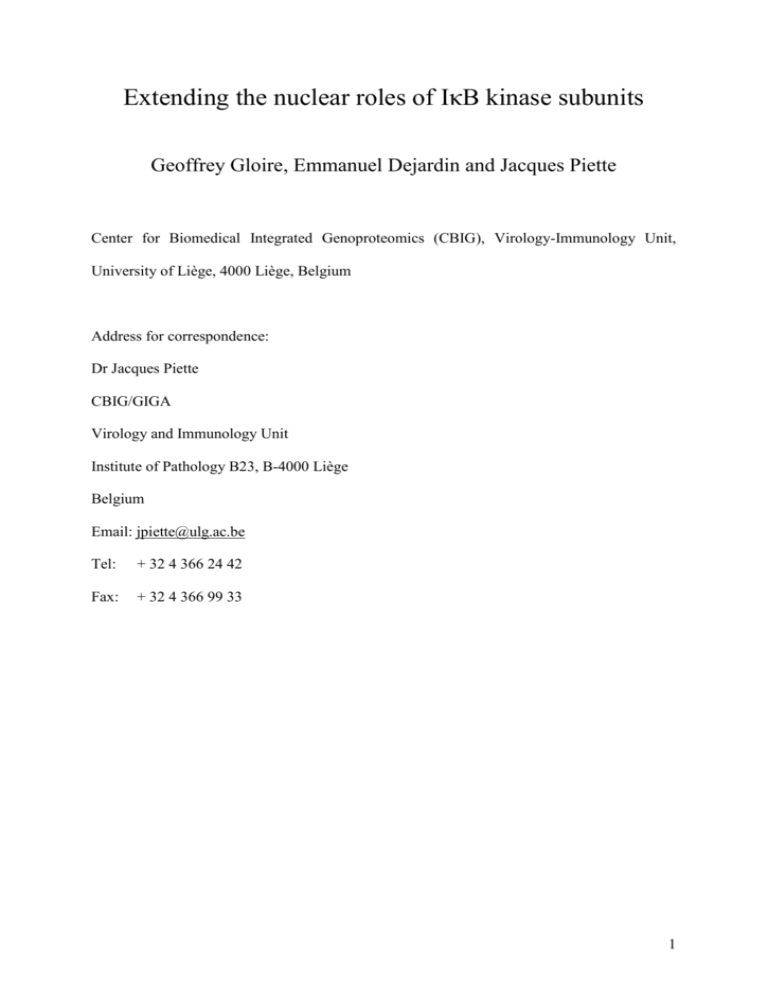
Extending the nuclear roles of IκB kinase subunits Geoffrey Gloire, Emmanuel Dejardin and Jacques Piette Center for Biomedical Integrated Genoproteomics (CBIG), Virology-Immunology Unit, University of Liège, 4000 Liège, Belgium Address for correspondence: Dr Jacques Piette CBIG/GIGA Virology and Immunology Unit Institute of Pathology B23, B-4000 Liège Belgium Email: jpiette@ulg.ac.be Tel: + 32 4 366 24 42 Fax: + 32 4 366 99 33 1 Abbreviations NF-κB : nuclear factor κB; IκB: inhibitor of κB; IKK: IκB Kinase; TNFα: tumor necrosis factorα; IL-1, -2, -6, -8, : interleukin -1, -2, -6, -8; MCP-1: monocyte chemoattractant protein1; MIP-1α: macrophage inflammatory protein-1α; ICAM-1: intercellular adhesion molecule1; VCAM-1: vascular cell adhesion molecule-1; COX-2: cyclooxygenase-2; iNOS: inducible nitric oxide synthase; MHC: major histocompatibility complex; XIAP-1: X chromosomelinked IAP; GADD45β: growth arrest and DNA damage-inducing protein 45β; ELKS: (E), leucine (L), lysine (K), and serine (S); EGF: epidermal growth factor; SMRT: silencing mediator for retinoic acid and thyroid hormone receptor; CBP: CREB binding protein; ATM: atexia telengiactasia mutated; PIDD: p53-induced protein with a death domain ; MEF : mouse embryonic fibroblast. 2 ABSTRACT The transcription factor NF-κB plays a key role in a wide variety of cellular processes such as innate and adaptive immunity, cellular proliferation, apoptosis and development. In unstimulated cells, NF-κB is sequestered in the cytoplasm through its tight association with inhibitory proteins called IκBs, comprising notably IκBα. A key step in NF-κB activation is the phosphorylation of IκBα by the so-called IκB Kinase (IKK) complex, which targets the inhibitory protein for proteasomal degradation and allows the freed NF-κB to enter the nucleus where it can transactivate its target genes. The IKK complex is composed of two catalytic subunits called IKKα and IKKβ, and a regulatory subunit called NEMO/IKKγ. Despite their key role in mediating IκBα phosphorylation in the cytoplasm, recent works have provided evidence that IKK subunits also translocate into the nucleus to regulate NFκB-dependent and independent gene expression, paving the way of a novel and exciting field of research. In this review, we will describe the current knowledge in that research area. 3 1. The IKK/NF-κB pathway The transcription factor NF-κB regulates the expression of hundreds of genes implicated in innate and adaptive immunity (1), cellular proliferation and survival (2,3) and organ development (4). NF-κB consists of homo or heterodimers of a group of five proteins, namely NF-κB1 (p50 and its precursor p105), NF-κB2 (p52 and its precursor p100), p65/RelA, c-Rel and RelB (5). p65/RelA, c-Rel and RelB contain a transactivation domain, whereas p50 and p52 do not. p50 or p52 homodimers are thus transcriptionally inactive and repress transcription. It should however be noted that Bcl-3/p50 complexes have been reported to bind NF-κB cis-elements and activate transcription (6). In the resting state, NF-κB is sequestered in the cytoplasm of the cell through its tight association with inhibitory proteins called IκBs, comprising IκBα, IκB, IκB, IκB, Bcl3, p100 and p105. Upon cell stimulation, IκB proteins are rapidly phosphorylated and degraded by the proteasome, and the freed NF-κB translocates into the nucleus to regulate the expression of multiple target genes (5). Among those genes, one can cite those coding for cytokines (TNFα, IL-1, IL-6), chemokines (MCP-1, IL-8, MIP-1α), adhesion molecules (ICAM-1, VCAM-1), enzymes (COX-2, iNOS), immune receptors (MHC, IL-2 receptor, IFN-γ receptor), antiapoptotic proteins (XIAP, GADD45β), antioxidant enzymes (MnSOD) and proteins involved in the negative feed-back of NF-κB activation (A20, IκBα) (7). Numerous components of innate and adaptive immunity are capable of activating the NFκB via two distinct activating pathways. This first pathway, called canonical or classical pathway, is induced by proinflammatory cytokines (TNFα, IL-1β) (8,9), Toll-like receptors (TLRs) (10) or antigen receptors (TCR, BCR) ligation (1,11,12) and, in some 4 cell-types, by oxidative or genotoxic stress (13-15). All these stimuli converge to the activation of the so-called IκB-kinase (IKK) complex, which includes the scaffold protein NF-κB essential modulator (NEMO, also called IKKγ) (16) and the IKKα and IKKβ kinases (17). Once activated by phosphorylation, the IKK complex phosphorylates IκBα on Ser32 and Ser36. The inhibitor is then ubiquitinated and subsequently degraded via the proteasome pathway, thereby allowing NF-κB translocation into the nucleus where it activates the transcription of immune and inflammatory mediators. Beside this classical activation, a novel NEMO-independent NF-κB-activating pathway was described. It is induced by BAFF (B-cell activating factor) (18), LT (lymphotoxin ) (19), CD40 ligand (20) and human T-cell leukemia (HTLV) and Epstein-Barr (EBV) virus (21,22). It enhances NF-κB-inducing kinase (NIK)- and IKKdependent processing of p100 into p52. This subunit binds DNA in association with its partners and stimulates the transcription of genes important for secondary lymphoid organ development, B cell homeostasis and adaptive immunity (1). 2. The IKK complex 2.1. Biochemical properties Pioneer biochemical studies have identified a high molecular weight complex of 700-900 kDa capable of phosphorylating IκBα on Ser32 and Ser36 in unstimulated cells or upon cytokine stimulation (17,23-26). This complex, called IKK complex, contains three major subunits: IKKα (initially termed CHUK), IKKβ and NEMO/IKKγ (for NF-κB Essential Modulator, also called IKKAP1 or FIP-3). IKKα and IKKβ are serine/threonine kinases characterized by the presence of an N-terminal kinase domain, a C-terminal helix-loophelix domain and a leucine zipper domain. A nuclear localisation sequence was also 5 recently found within the IKKα kinase domain ((27) and see below) (Figure 1). Both kinases are capable of phosphorylating various members of the IκB family, notably IκBα on Ser32 and Ser36 and IκBβ on Ser19 and Ser23 (28). NEMO/IKKγ was discovered through genetic complementation cloning in an NF-κB unresponsive cell line and subsequently by biochemical purification (16,29,30). It is the regulatory subunit of the IKK complex and it does not share identities with IKKα and IKKβ. It contains a Cterminal zinc finger-like domain, N- and C-terminal coiled-coil domains, two α-helices and a leucine zipper. NEMO/IKKγ interacts with both IKKα and IKKβ through their socalled NEMO binding domain (NBD), which is composed of a C-terminal hex peptide sequence (Leu-Asp-Trp-Ser-Trp-Leu) (31) (Figure 1). This association with NEMO/IKKγ is required for the inducible IκB kinase activity. Although it is still a matter of debate, the stoichiometry of the IKK complex subunits seems to be a heterodimer of IKKα and IKKβ associated with two NEMO/IKKγ (32). NEMO/IKKγ has also been reported to oligomerize, which appears to be important for IKK complex activation (33). Other proteins are constitutively associated with the IKK complex. Among them, one can cite chaperones like HSP90, HSP70 and Cdc37 (34,35). Treatment of cells with geldanamycin, which inhibits HSP90 function, results in disruption of HSP90 and cdc37 from the IKK complex and in inhibition of TNFα-induced IKK activation. This inhibition is caused by an absence of recruitment of IKK to TNFR-1 upon TNFα stimulation (34). Overexpression of HSP70 leads to its association with NEMO/IKKγ, thereby inhibiting IKK complex assembly. This in turn impairs TNFα-mediated NF-κB activation, thereby enhancing TNFα-induced apoptosis (35). Recently, the regulatory protein ELKS has also been reported to be associated with the IKK complex. ELKS is necessary for early NF-κB activation by TNFα or IL-1 and for the interaction between the IKK complex and 6 IκBα (36). ELKS is also required for DNA damage-induced IKK activation ((37) and see below). 2.2. Genetic approach Generation of knockout mice for IKK complex subunits has offered new tools to study their biological role and confirm or invalidate data obtained from biochemical studies. ikkβ-/- mice die as embryos (at 14.5 days of gestation) due to extensive liver damage from apoptosis. They have both reduced basal and cytokine-induced NF-κB activation due to complete loss of IKK complex activity, suggesting that IKKβ plays the main role in NFκB activation. Indeed, in the absence of IKKβ and despite its association with NEMO/IKKγ, IKKα is unresponsive to IKK activators in term of IκBα phosphorylation (38-40). Embryonic fibroblasts from ikkβ -/- mice also exhibit enhanced apoptosis in response to TNFα, and liver damage observed in those mice can be rescued by the inactivation of the gene coding for tumor necrosis factor receptor-1, highlighting the crucial role of IKKβ and NF-κB pathway in protecting cells from TNF-induced apoptosis (39,41). NEMO/IKKγ deficient mice also exhibit liver degeneration, but their phenotype is more severe than ikkβ-/- mice. In nemo/ikkγ-/- mice, the onset of the liver phenotype appears 12 hours earlier (mutant embryos die at E12.5-E13.0) and liver damage is more serious. Moreover, cytokine-induced IκBα phosphorylation and NF-κB DNA binding activity are completely abolished in nemo/ikkγ-/- mouse embryonic fibroblasts (MEFs) (42). In humans, mutations in the NEMO/IKKγ locus are associated with two distinct X-linked human diseases, incontinentia pigmenti (IP) and immunodeficiencies associated or not with anhidrotic ectodermal dysplasia (ID or EDA-ID) (43,44). IP is an X-linked genodermatosis affecting almost exclusively females. Skin defects are also often 7 associated with ophthalmologic, odontological and neurological problems. IP is caused in most cases by a NEMO/IKKγ locus rearrangement generating a truncated 133 aa protein devoid of activity but still able to interact with IKK. Foetus-derived primary fibroblasts from IP patients exhibit a lack of NF-κB activation and IκBα degradation and are sensitive to TNFα-induced apoptosis (45). A surprising feature of IP patients is X-inactivation skewing observed in peripheral blood cells, and probably in hepatocytes. This counterselection against cells expressing the mutated X chromosome is less complete in skin, which would account for dermatosis in IP patients, but also for the absence of immunological defects and liver damage, on the contrary of NEMO/IKKγ-/- mice. A mouse model of IP has been generated to understand more deeply molecular events leading to IP dermatosis (46). IP patients exhibit at birth a “mosaic skin” composed of cells expressing either wt or mutated NEMO/IKKγ. Via an unknown mechanism, mutated cells produce proinflammatory cytokines, such as IL-1β, thereby inducing the release of TNFα from wt cells. This induces inflammation in wt cells and apoptosis in NEMO/IKKγ mutated cells. This would account for blisters and inflammatory responses observed in the skin in the early stages in IP pathology, followed at the end by an atrophic stage corresponding to the self-elimination of mutated cells. EDA-ID is an X-linked pathology only affecting males. Patients exhibit severe sensitivity to infections and abnormal development of skin adnexes. It is caused by missense mutations or deletions affecting NEMO/IKKγ zinc finger (47). These mutations lead to reduced but not abolished NF-κB actvation causing impaired response of blood lymphocytes to LPS or proinflammatory cytokines, thereby leading to recurrent bacterial infections (48). B cells and NK cells also exhibit abnormalities, but T cells seem to proliferate normally. NEMO/IKKγ mutations can also cause ID without EDA (49). 8 The phenotype of IKKα-deficient mice was more surprising and raised new questions about its biological functions. ikkα-/- mice die shortly after birth due to multiple developmental defects. They do not exhibit liver apoptosis, but rather show defects in limb and skeletal patterning and proliferation as well as in differentiation of epidermal keratinocytes (50-52). Cytokine-induced IκBα phosphorylation and degradation is unaffected in ikkα-/- MEFs, but conflicting results were obtained from NF-κB DNA binding activity and subsequent NF-κB target gene expression analyses: Li et al. observed a reduction of TNFα- and IL-1-induced NF-κB binding activity together with a decrease in IκBα, IL6 and M-CSF gene expression (51). However, Takeda et al. and Hu et al. reported a normal NF-κB DNA binding activity and an IL6 and IκBα synthesis (50,52). More recently, M. Karin’s group explored more deeply the role of IKKα in keratinocyte differentiation and demonstrated that this phenomenon does not require NF-κB activation, but, instead, relies on a soluble factor production mediated by IKKα independently of its kinase activity (53). Taken together, these genetic studies have demonstrated that IKKβ is the major kinase phosphorylating IκBα upon pro-inflammatory cytokines stimulation, and that NEMO/IKKγ also plays a key role in IKK complex activity. In most cases, IKKα does not seem to play a key role in the classical pathway of NF-κB activation, but instead is important for many developmental aspects independently of its kinase activity. Subsequent studies have, however, demonstrated that IKKα kinase activity is crucial in the cytoplasm for activating the alternative NF-κB activation pathway ((54) and see above) and for RANKL-induced NF-κB activation, a key step involved in cyclin D1 expression during mammary gland development (55). Accordingly, IKKαAA mice (which express an IKKα where its activating phosphoacceptor sites are replaced by alanines) 9 present defects in B cell maturation as well as lymphoid organ development and mammary gland development (54,55). 3. Nuclear role of IKK complex subunits Very recently, several authors have demonstrated that IKK subunits can enter the nucleus (56,57) and regulate many aspects of NF-κB dependent and independent gene expression (58). In this chapter, we will summarize data obtained from these studies. 3.1. Nuclear role of IKKα IKKα is the IKK complex subunit whose nuclear role has been the most extensively studied. IKKα acts at different levels by modulating NF-κB-dependent and -independent gene expression. 3.1.1. Nuclear role of IKKα in NF-κB-dependent gene expression IKKα was shown to regulate at least three steps of the NF-κB-dependent gene transcription. Using laminin attachment as a NF-κB inducer in epithelial cells, Mayo’s group recently showed that IKKα mediates derepression of cIAP-2 and IL-8 gene promoters, a prerequisite that allows NF-κB-mediated transcription (59). Indeed, in the unstimulated state, the promoters NF-κB binding sites are repressed by transcriptionally inactive p50 or p52 homodimers that recruit repressor complexes such as SMRT and HDAC3 (Figure 2). To achieve transcription, these repressors must be removed through a process called derepression. IKKα was first shown to phosphorylate SMRT, thereby promoting its nuclear export (together with HDAC3) and degradation via the proteasome pathway, thus allowing transcriptionally active p50/p65 complexes to stimulate transcription (59). In a second phase, IKKα phosphorylates chromatin-bound p65 Ser536, which, together with SMRT phosphorylation (SMRT rapidly returns to the chromatin- 10 bound p50/p65 complexes after its first derepression from p50 homodimers), prevents HDAC3 recruitment to chromatin and allows p300 to acetylate p65 at lys310, which is required for full transcription (60) (Figure 2). Altogether, these results clearly establish a nuclear role of IKKα in derepressing NF-κB target genes. In TNFα-stimulated mouse embryonic fibroblasts, Anest et al. and Yamamoto et al. demonstrated for the first time a recruitment of IKKα, together with p65 and CBP, onto NF-κB target genes promoters (such as IκBα, IL-8 or IL-6) (61,62). This association induces IKKα-mediated phosphorylation of histone H3 on Ser10, triggering its subsequent acetylation on Lys14 by the IKKα-associated CBP, a crucial step in modulating chromatin accessibility at NF-κB responsive promoters (Figure 3). Consistently, they showed that IKKα-/- MEFs are defective in TNFα-induced IκBα, IL-6 or IL-8 gene transcription (61,62). Very recently, IKKα was also shown to be recruited onto promoters of multiple NF-κB-dependent pro-inflammatory genes in macrophages treated by LPS, and to phosphorylate histone H3 (63). This IKKα-mediated histone H3 phosphorylation is enhanced by NIK, which appears to translocate into the nucleus upon LPS stimulation (63). A third role of IKKα in modulating NF-κB-dependent gene expression was discovered by Lawrence and Bebien et al. (64). Surprisingly, these authors reported a role for IKKα in the negative regulation of macrophage activation and inflammation. Using mice expressing an inactivable IKKα (IKKα AA), they showed that IKKα activity is crucial to limit the inflammatory response to Gram-negative infection. Indeed, macrophages from IKKαAA/AA mice exhibit increased cytokine, chemokine, antiapoptotic and iNOS gene expression upon LPS stimulation (64). In the same study, further molecular analysis revealed a prolonged nucleus residence of both p65 and c-Rel in macrophages from IKKα AA/AA mice stimulated by LPS, due to the abolition of p65 C-terminal phosphorylation and 11 proteasomal degradation (64) (Figure 4). In this case, IKKα might act as a chromatinbound p65 C-terminal kinase responsible for p65 turnover, which, in turn, limits macrophage activation and inflammation. This observation was partially confirmed by Verma’s group in IKKα-/- macrophages (65), although they were not able to detect LPSinduced p65 degradation and turnover. Rather, they suggested that NF-κB hyperactivation in these cells is caused by enhanced IκB kinase activity of IKKβ in the absence of IKKα, which, in turn, increases neosynthetised IκBα degradation (65). 3.1.2. Nuclear role of IKKα in NF-κB-independent gene expression As mentioned above, IKKα is required for epidermal keratinocyte differentiation independently of its kinase activity and NF-κB activity (53). More recently, the crucial nuclear role of IKKα in this phenomenon was delineated by Sil et al. (27). They showed that conditional expression of WT IKKα or IKKα AA in basal keratinocytes is sufficient to rescue the morphogenetic defects of IKKα-/- mice. Furthermore, they identified a functional nuclear localization sequence (NLS) in the IKKα kinase domain. Inactivation of IKKα NLS by mutagenesis represses keratinocyte differentiation, indicating that IKKα exerts its function within the nucleus of basal keratinocytes in the epidermis (27). The nuclear role of IKKα was also reported on NF-κB-independent genes. For example, IKKα mediates EGF-induced histone H3 phosphorylation at the c-fos promoter, a prerequisite to optimal c-fos gene expression (66). IKKα also binds promoters of estrogen-responsive genes such as cyclin D1 and c-myc and activates their transcription by forming a transcription complex with the estrogen receptor ERα and the coactivator AIB1/SRC-3 (67). Another estrogen-responsive gene implicated in cell-cycle progression, E2F1, is also regulated by IKKα (68). 12 3.2. Nuclear role of NEMO/IKKγ Unlike IKKα, NEMO/IKKγ role in gene regulation has not clearly been established. NEMO/IKKγ was reported to shuttle between the cytoplasm and the nucleus in a CRM-1dependent manner (56,69). It competes in vitro with IKKα and p65 for binding to the nuclear coactivator CBP, thereby repressing NF-κB dependent gene expression (69). NEMO/IKKγ also interacts with Hypoxia-inducible Factor-2α (HIF-2α) and increases its activity via p300 recruitment (70). The current knowledge on the nuclear role of NEMO/IKKγ has come from studies related to NF-κB activation by DNA damage. Since this signalling pathway triggers IKK complex activation, the challenge in that research area has been to find what the molecular link was between DNA damage in the nucleus and IKK complex activation in the cytoplasm. It appears that NEMO/IKKγ plays that role. In response to DNA damage, NEMO/IKKγ undergoes a series of modifications within the nucleus. NEMO/IKKγ is first sumoylated on Lys277 and Lys309, a modification that requires its ZF domain. This sumoylation appears to retain NEMO/IKKγ in the nucleus where it is subsequently mono-ubiquitinated on the same residues (71,72) (Figure 5). This ubiquitination requires NEMO/IKKγ Ser85 phosphorylation by the ATM kinase, a master regulator in cell-cycle control and DNAdamage responses. NEMO/IKKγ ubiquitination is essential for its nuclear export, together with ATM, and for their subsequent interaction with the IKK complex in the cytoplasm via the IKK-associated protein ELKS. This induces IKK activation, NF-κB nuclear translocation and transcription of antiapototic genes (37,73) (Figure 5). Recently, nuclear events leading to NEMO/IKKγ sumoylation upon DNA damage were highlighted. This sumoylation is increased by PIDD, a protein implicated in cell-cycle arrest and apoptosis downstream of p53 (74). PIDD forms a complex with NEMO/IKKγ and RIP1 in the 13 nucleus and increases sumoylation and subsequent phosphorylation and ubiquitination of NEMO/IKKγ, which enhances NF-κB activation (75,76) (Figure 5). 3.3. Nuclear role of IKKβ IKKβ appears to be a nearly entirely cytoplasmic protein (56,69). However, it has been demonstrated to be recruited to NF-κB-dependent promoters (61), but this observation was not confirmed by the Gaynor’s group companion paper (62). IKKβ is also required to activate a subset of interferon γ-stimulated genes (77) and to be recruited to the hes1 promoter, a Notch-target gene (78). In this case, IKKβ would induce phosphorylation of promoter bound IκBα (which acts as corepressor of the hes1 gene transcription) and its subsequent degradation, thereby allowing gene transcription (78). 4. Conclusion and perspectives The recent discoveries of nuclear functions of IκB Kinase subunits has opened up new and exciting fields of research in terms of gene regulation and signalling pathway from the nucleus to the cytoplasm. IKKα is the protein whose nuclear role has been the most extensively investigated. It is involved in a nuclear process called derepression, which allows removal of corepressors, and also mediates phosphorylation and acetylation of histone H3, two processes required for a fully active transcription. IKKα can both act on NF-κB and non-NF-κB target genes, thereby making this protein a master regulator of gene expression machinery. The main interrogation that comes out of this data arises from the total discrepancy between the phenotype of ikkα-/- mice and the strong molecular data obtained with embryonic fibroblasts from these mice. ikkα-/- mice have no defect in 14 NF-κB signalling and NF-κB target gene expression (as demonstrated at least by (50) and (52)), but only display morphological abnormalities nearly completely rescued by knocking in IKKα wt or AA in epidermal keratinocytes (27). However, two studies on ikkα-/- MEFs clearly position IKKα as an histone H3 kinase essential for NF-κB target gene expression, which would account for a phenotype resembling those of ikkβ-/- or nemo/ikkγ-/- mice, i.e. liver apoptosis (61,62). These discrepancies suggest that IKKα’s nuclear role is only restricted to some cell-types, and not to the majority of organs. It should also be noted that, among the three groups that generated and characterized ikkα-/mice, Verma’s one was the sole to report a defect in NF-κB target gene expression in the absence of IKKα (51), an observation in accordance with results obtained later about IKKα’s nuclear function (61,62). Another intriguing feature is that macrophages from ikkα-/- or ikkαAA/AA mice display enhanced NF-κB activation and NF-κB target gene expression, as opposed to the MEFs counterparts (64,65), highlighting a new function of IKKα in mediating p65 and c-Rel turnover in the nucleus and the cell-type dependence of IKKα’s biological function. Once again, these data are discrepant with a very recent paper reporting that IKKα also functions as a histone H3 kinase in the mouse macrophage cell line RAW 264.7 (63), which would account for inhibition of NF-κB target genes expression, not for enhanced inflammation in macrophages from ikkα-/- or ikkαAA/AA mice. Despite the fact that NEMO/IKKγ’s nuclear function was initially described as a mediator of NF-κB gene expression (69), most of our knowledge about its nuclear action is related to DNA damage (14). NEMO/IKKγ, through a series of post-translational modifications (notably sumoylation), acts by relaying nuclear information to the cytoplasmic IKK complex upon genotoxic stress. A central question about that mechanism is to understand how NEMO/IKKγ translocates into the nucleus, since sumoylation only appears to retain it in the nucleus, but does not account for its nuclear migration. Furthermore, sumoylation 15 is a predominantly nuclear process (72). NEMO/IKKγ does not contain any classical NLS (69), and probably relies on an unknown NLS-bearing protein to achieve its nuclear translocation that remains to be discovered. As mentioned above, knowledge about the nuclear role of NEMO/IKKγ in regulating NF-κB-mediated gene expression remains poorly understood and needs further investigation. Since NEMO/IKKγ interacts with CBP, it is possible that, like IKKα, it mediates acetylation events crucial in chromatin remodelling and transcription. The nuclear role of IKKβ is even more poorly understood. Although it is able to associate with several promoters, its exact function on chromatin is totally unknown. Aguilera et al. have proposed a model where IKKβ phosphorylates the chromatin-bound IκBα (which acts as a repressor on some promoters), thereby allowing IκBα degradation and promoter derepression (78). It is possible that this IκBα-mediated repression is generalized to many promoters, and that IKKβ has a crucial role for their derepression. Acknowledgements. We thank Dr Jean-Yves Matroule for critical reading of this manuscript. supported by a grant from the Télévie (FNRS, Brussels, Belgium). GG was ED and JP are Research Associate and Research Director from the FNRS, respectively. 16 REFERENCES 1. 2. 3. 4. 5. 6. 7. 8. 9. 10. 11. 12. 13. 14. 15. Bonizzi, G., and Karin, M. (2004) Trends Immunol 25, 280-288 Papa, S., Bubici, C., Zazzeroni, F., Pham, C. G., Kuntzen, C., Knabb, J. R., Dean, K., and Franzoso, G. (2006) Cell Death Differ Siebenlist, U., Brown, K., and Claudio, E. (2005) Nat Rev Immunol 5, 435-445 Weih, F., and Caamano, J. (2003) Immunol Rev 195, 91-105 Hayden, M. S., and Ghosh, S. (2004) Genes Dev 18, 2195-2224 Bours, V., Franzoso, G., Azarenko, V., Park, S., Kanno, T., Brown, K., and Siebenlist, U. (1993) Cell 72, 729-739 Pahl, H. L. (1999) Oncogene 18, 6853-6866 Martin, M. U., and Wesche, H. (2002) Biochim Biophys Acta 1592, 265-280 Devin, A., Cook, A., Lin, Y., Rodriguez, Y., Kelliher, M., and Liu, Z. (2000) Immunity 12, 419-429 O'Neill L, A. (2006) Curr Opin Immunol 18, 3-9 Weil, R., and Israel, A. (2004) Curr Opin Immunol 16, 374-381 Weil, R., and Israel, A. (2006) Cell Death Differ Gloire, G., Charlier, E., Rahmouni, S., Volanti, C., Chariot, A., Erneux, C., and Piette, J. (2006) Oncogene Janssens, S., and Tschopp, J. (2006) Cell Death Differ 13, 773-784 Gloire, G., Legrand-Poels, S., and Piette, J. (2006) Biochemical Pharmacology In press 17 16. 17. 18. 19. 20. 21. 22. 23. 24. 25. 26. 27. 28. 29. 30. 31. 32. 33. 34. 35. 36. 37. 38. 39. 40. 41. 42. 43. Yamaoka, S., Courtois, G., Bessia, C., Whiteside, S. T., Weil, R., Agou, F., Kirk, H. E., Kay, R. J., and Israel, A. (1998) Cell 93, 1231-1240 Zandi, E., Rothwarf, D. M., Delhase, M., Hayakawa, M., and Karin, M. (1997) Cell 91, 243-252 Claudio, E., Brown, K., Park, S., Wang, H., and Siebenlist, U. (2002) Nat Immunol 3, 958-965 Dejardin, E., Droin, N. M., Delhase, M., Haas, E., Cao, Y., Makris, C., Li, Z. W., Karin, M., Ware, C. F., and Green, D. R. (2002) Immunity 17, 525-535 Coope, H. J., Atkinson, P. G., Huhse, B., Belich, M., Janzen, J., Holman, M. J., Klaus, G. G., Johnston, L. H., and Ley, S. C. (2002) Embo J 21, 5375-5385 Eliopoulos, A. G., Caamano, J. H., Flavell, J., Reynolds, G. M., Murray, P. G., Poyet, J. L., and Young, L. S. (2003) Oncogene 22, 7557-7569 Xiao, G., Cvijic, M. E., Fong, A., Harhaj, E. W., Uhlik, M. T., Waterfield, M., and Sun, S. C. (2001) Embo J 20, 6805-6815 Chen, Z. J., Parent, L., and Maniatis, T. (1996) Cell 84, 853-862 DiDonato, J. A., Hayakawa, M., Rothwarf, D. M., Zandi, E., and Karin, M. (1997) Nature 388, 548-554 Mercurio, F., Zhu, H., Murray, B. W., Shevchenko, A., Bennett, B. L., Li, J., Young, D. B., Barbosa, M., Mann, M., Manning, A., and Rao, A. (1997) Science 278, 860-866 Woronicz, J. D., Gao, X., Cao, Z., Rothe, M., and Goeddel, D. V. (1997) Science 278, 866-869 Sil, A. K., Maeda, S., Sano, Y., Roop, D. R., and Karin, M. (2004) Nature 428, 660664 DiDonato, J., Mercurio, F., Rosette, C., Wu-Li, J., Suyang, H., Ghosh, S., and Karin, M. (1996) Mol Cell Biol 16, 1295-1304 Mercurio, F., Murray, B. W., Shevchenko, A., Bennett, B. L., Young, D. B., Li, J. W., Pascual, G., Motiwala, A., Zhu, H., Mann, M., and Manning, A. M. (1999) Mol Cell Biol 19, 1526-1538 Li, Y., Kang, J., Friedman, J., Tarassishin, L., Ye, J., Kovalenko, A., Wallach, D., and Horwitz, M. S. (1999) Proc Natl Acad Sci U S A 96, 1042-1047 May, M. J., Marienfeld, R. B., and Ghosh, S. (2002) J Biol Chem 277, 45992-46000 Miller, B. S., and Zandi, E. (2001) J Biol Chem 276, 36320-36326 Agou, F., Traincard, F., Vinolo, E., Courtois, G., Yamaoka, S., Israel, A., and Veron, M. (2004) J Biol Chem 279, 27861-27869 Chen, G., Cao, P., and Goeddel, D. V. (2002) Mol Cell 9, 401-410 Ran, R., Lu, A., Zhang, L., Tang, Y., Zhu, H., Xu, H., Feng, Y., Han, C., Zhou, G., Rigby, A. C., and Sharp, F. R. (2004) Genes Dev 18, 1466-1481 Ducut Sigala, J. L., Bottero, V., Young, D. B., Shevchenko, A., Mercurio, F., and Verma, I. M. (2004) Science 304, 1963-1967 Wu, Z. H., Shi, Y., Tibbetts, R. S., and Miyamoto, S. (2006) Science 311, 1141-1146 Li, Z. W., Chu, W., Hu, Y., Delhase, M., Deerinck, T., Ellisman, M., Johnson, R., and Karin, M. (1999) J Exp Med 189, 1839-1845 Li, Q., Van Antwerp, D., Mercurio, F., Lee, K. F., and Verma, I. M. (1999) Science 284, 321-325 Tanaka, M., Fuentes, M. E., Yamaguchi, K., Durnin, M. H., Dalrymple, S. A., Hardy, K. L., and Goeddel, D. V. (1999) Immunity 10, 421-429 Senftleben, U., Li, Z. W., Baud, V., and Karin, M. (2001) Immunity 14, 217-230 Rudolph, D., Yeh, W. C., Wakeham, A., Rudolph, B., Nallainathan, D., Potter, J., Elia, A. J., and Mak, T. W. (2000) Genes Dev 14, 854-862 Courtois, G., Smahi, A., and Israel, A. (2001) Trends Mol Med 7, 427-430 18 44. 45. 46. 47. 48. 49. 50. 51. 52. 53. 54. 55. 56. 57. 58. 59. 60. 61. 62. 63. 64. Courtois, G., and Smahi, A. (2006) Cell Death Differ 13, 843-851 Smahi, A., Courtois, G., Vabres, P., Yamaoka, S., Heuertz, S., Munnich, A., Israel, A., Heiss, N. S., Klauck, S. M., Kioschis, P., Wiemann, S., Poustka, A., Esposito, T., Bardaro, T., Gianfrancesco, F., Ciccodicola, A., D'Urso, M., Woffendin, H., Jakins, T., Donnai, D., Stewart, H., Kenwrick, S. J., Aradhya, S., Yamagata, T., Levy, M., Lewis, R. A., and Nelson, D. L. (2000) Nature 405, 466-472 Nenci, A., Huth, M., Funteh, A., Schmidt-Supprian, M., Bloch, W., Metzger, D., Chambon, P., Rajewsky, K., Krieg, T., Haase, I., and Pasparakis, M. (2006) Hum Mol Genet 15, 531-542 Zonana, J., Elder, M. E., Schneider, L. C., Orlow, S. J., Moss, C., Golabi, M., Shapira, S. K., Farndon, P. A., Wara, D. W., Emmal, S. A., and Ferguson, B. M. (2000) Am J Hum Genet 67, 1555-1562 Doffinger, R., Smahi, A., Bessia, C., Geissmann, F., Feinberg, J., Durandy, A., Bodemer, C., Kenwrick, S., Dupuis-Girod, S., Blanche, S., Wood, P., Rabia, S. H., Headon, D. J., Overbeek, P. A., Le Deist, F., Holland, S. M., Belani, K., Kumararatne, D. S., Fischer, A., Shapiro, R., Conley, M. E., Reimund, E., Kalhoff, H., Abinun, M., Munnich, A., Israel, A., Courtois, G., and Casanova, J. L. (2001) Nat Genet 27, 277285 Orange, J. S., Levy, O., Brodeur, S. R., Krzewski, K., Roy, R. M., Niemela, J. E., Fleisher, T. A., Bonilla, F. A., and Geha, R. S. (2004) J Allergy Clin Immunol 114, 650-656 Takeda, K., Takeuchi, O., Tsujimura, T., Itami, S., Adachi, O., Kawai, T., Sanjo, H., Yoshikawa, K., Terada, N., and Akira, S. (1999) Science 284, 313-316 Li, Q., Lu, Q., Hwang, J. Y., Buscher, D., Lee, K. F., Izpisua-Belmonte, J. C., and Verma, I. M. (1999) Genes Dev 13, 1322-1328 Hu, Y., Baud, V., Delhase, M., Zhang, P., Deerinck, T., Ellisman, M., Johnson, R., and Karin, M. (1999) Science 284, 316-320 Hu, Y., Baud, V., Oga, T., Kim, K. I., Yoshida, K., and Karin, M. (2001) Nature 410, 710-714 Senftleben, U., Cao, Y., Xiao, G., Greten, F. R., Krahn, G., Bonizzi, G., Chen, Y., Hu, Y., Fong, A., Sun, S. C., and Karin, M. (2001) Science 293, 1495-1499 Cao, Y., Bonizzi, G., Seagroves, T. N., Greten, F. R., Johnson, R., Schmidt, E. V., and Karin, M. (2001) Cell 107, 763-775 Birbach, A., Gold, P., Binder, B. R., Hofer, E., de Martin, R., and Schmid, J. A. (2002) J Biol Chem 277, 10842-10851 Ear, T., Cloutier, A., and McDonald, P. P. (2005) J Immunol 175, 1834-1842 Massa, P. E., Li, X., Hanidu, A., Siamas, J., Pariali, M., Pareja, J., Savitt, A. G., Catron, K. M., Li, J., and Marcu, K. B. (2005) J Biol Chem 280, 14057-14069 Hoberg, J. E., Yeung, F., and Mayo, M. W. (2004) Mol Cell 16, 245-255 Hoberg, J. E., Popko, A. E., Ramsey, C. S., and Mayo, M. W. (2006) Mol Cell Biol 26, 457-471 Anest, V., Hanson, J. L., Cogswell, P. C., Steinbrecher, K. A., Strahl, B. D., and Baldwin, A. S. (2003) Nature 423, 659-663 Yamamoto, Y., Verma, U. N., Prajapati, S., Kwak, Y. T., and Gaynor, R. B. (2003) Nature 423, 655-659 Park, G. Y., Wang, X., Hu, N., Pedchenko, T. V., Blackwell, T. S., and Christman, J. W. (2006) J Biol Chem Lawrence, T., Bebien, M., Liu, G. Y., Nizet, V., and Karin, M. (2005) Nature 434, 1138-1143 19 65. 66. 67. 68. 69. 70. 71. 72. 73. 74. 75. 76. 77. 78. Li, Q., Lu, Q., Bottero, V., Estepa, G., Morrison, L., Mercurio, F., and Verma, I. M. (2005) Proc Natl Acad Sci U S A 102, 12425-12430 Anest, V., Cogswell, P. C., and Baldwin, A. S., Jr. (2004) J Biol Chem 279, 3118331189 Park, K. J., Krishnan, V., O'Malley, B. W., Yamamoto, Y., and Gaynor, R. B. (2005) Mol Cell 18, 71-82 Tu, Z., Prajapati, S., Park, K. J., Kelly, N. J., Yamamoto, Y., and Gaynor, R. B. (2006) J Biol Chem 281, 6699-6706 Verma, U. N., Yamamoto, Y., Prajapati, S., and Gaynor, R. B. (2004) J Biol Chem 279, 3509-3515 Bracken, C. P., Whitelaw, M. L., and Peet, D. J. (2005) J Biol Chem 280, 1424014251 Huang, T. T., Wuerzberger-Davis, S. M., Wu, Z. H., and Miyamoto, S. (2003) Cell 115, 565-576 Hay, R. T. (2004) Nat Cell Biol 6, 89-91 Bartek, J., and Lukas, J. (2006) Science 311, 1110-1111 Lin, Y., Ma, W., and Benchimol, S. (2000) Nat Genet 26, 122-127 Janssens, S., Tinel, A., Lippens, S., and Tschopp, J. (2005) Cell 123, 1079-1092 Wu, Z. H., Mabb, A., and Miyamoto, S. (2005) Cell 123, 980-982 Sizemore, N., Agarwal, A., Das, K., Lerner, N., Sulak, M., Rani, S., Ransohoff, R., Shultz, D., and Stark, G. R. (2004) Proc Natl Acad Sci U S A 101, 7994-7998 Aguilera, C., Hoya-Arias, R., Haegeman, G., Espinosa, L., and Bigas, A. (2004) Proc Natl Acad Sci U S A 101, 16537-16542 FIGURES LEGENDS Figure 1. Schematic structure of IKKα, IKKβ and NEMO/IKKγ. NLS: Nuclear Localisation Signal; HLH: Helix-Loop-Helix domain; NBD: NEMO/IKKγ binding domain; CC: Coiled-coil domains; ZF: Zinc finger domain. See text for details. Figure 2. IKKα-mediated derepression of the c-IAP-2 gene. In unstimulated cells, c-IAP-2 promoter is repressed by the binding of transcriptionally inactive p50 dimers that tether the corepressor HDAC3 and SMRT (A). Upon stimulation, IKKα phosphorylates SMRT, inducing its nuclear export (together with HDAC3) and proteasomal degradation (B). This initial derepression allows transcriptonally active p50/p65 dimers to bind to the promoter, together with SMRT which rapidly returns to the nucleus. At that time IKKα is crucial in maintaining an active derepression by phosphorylating SMRT and p65, two events necessary for preventing HDAC3 recruitment (C). Full transcription is then achieved through IKKα-mediated phosphorylation of p65 on Ser536, which allows its 20 acetylation by p300, a process that enhances its transactivation potential (D). Adapted from (60). Figure 3. IKKα is an histone H3 kinase. Upon TNFα stimulation of MEFs or LPS stimulation of mouse Raw 264.7 macrophages, IKKα enters into the nucleus, associates with p300 and binds promoters on which it phosphorylates histone H3. This histone H3 phosphorylation is a prerequisite for its acetylation by p300, which induces chromatin remodelling and transcription. In RAW 264.7 macrophages, NIK was also shown to enter into the nucleus and to enhance IKKα-mediated histone H3 phosphorylation (red arrows). See text for details. Figure 4. IKKα contributes to the resolution of inflammation in macrophages. Upon activation of TLR4 signalling by bacterial products like LPS, NF-κB is activated to induce macrophage inflammatory responses. Here, nuclear IKKα is required for the resolution of inflammation by mediating p65 turnover through its phosphorylation on Ser536. c-Rel turnover was also observed. Figure 5. The crucial role of NEMO/IKKγ in relaying signals from the nucleus to the cytoplasm upon DNA damage-induced NF-κB activation. In unstimulated cells, NEMO/IKKγ shuttles constitutively between the cytoplasm and the nucleus. Upon DNA damage, NEMO/IKKγ is sequestered into the nucleus by sumoylation, a process that requires PIDD and RIP1. NEMO/IKKγ is then ubiquitinated and phosphorylated in an ATM-dependent fashion, which triggers its nuclear export together with ATM. The cytoplasmic NEMO/IKKγ-ATM complex subsequently activates IKKs through binding with the regulatory protein ELKS, which allows NF-κB activation and cell survival. 21


